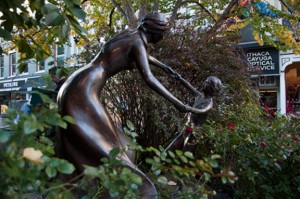Vibrant splashes of yellow, green and red accentuate the hue of blue 17th century icons painted on the walls of Green Street. While dozens of art pieces decorate downtown Ithaca, few people passing them take time to stop and consider their significance.

The initiative to liven the city with public art first began in 2002. Within the last year, the city increased the presence of public art in the community with its Public Art Plan, and abstract sculptures and colorful murals continue to be added to the city’s collection of street decor.
Brett Bossard, executive director of the Community Arts Partnership, the plan’s primary fundraising source, said public art is an integral part of maintaining Ithaca’s original image as an artistic community. He said visual art in public arenas engages people in a way that encourages conversation.
“Whether people like it or hate it, art provides a common starting point for conversation,” he said.
JoAnn Cornish, planning and development director for the city of Ithaca, said public art started as a grassroots effort in Ithaca. Artists and citizens approached the city to donate art and commission projects.
In collaboration with the Downtown Ithaca Alliance, the city began its public art initiative 11 years ago with one of the first Art in the Heart exhibitions.
Art in the Heart exhibits outdoor sculptures created by local artists who lend pieces to the community for six months.
One of the sculptures in the 2010 Art in the Heart exhibit is Marisa diPaola’s “Caterpillar’s Garden.” Located on the Commons, the mushroom-looking creation is entirely hand-built from recycled materials. A bright blue cap sits atop the electric yellow base and links with the vines that wrap around the tree trunk.
Freshman Sam Mason said she enjoys searching in the trees for hanging art, especially the recyclable mushroom design.
“It got me thinking about different ways of using plastic,” she said. “It’s a different way of defining art.”
Gary Ferguson, executive director of the Downtown Ithaca Alliance, said Art in the Heart gives artists like diPaola an opportunity to showcase their pieces and increase their visibility.
“There is always something new and fresh, and it always gives someone a reason to come back and take a look,” he said.
In the fall of 2002, the city of Ithaca’s Public Arts Commission developed a public art plan, the central goals of which included beautifying the city, supporting local artists and fostering community.
With help from the Downtown Ithaca Alliance and Community Arts Partnership, the Public Arts Commission has placed more than 12 permanent sculptures downtown. Ferguson said the goal of the initiative is to get people to come downtown and experience art each time they visit.
“It helps brand Ithaca and brand downtown as an art-friendly, artistic and creative community,” Ferguson said.
Along the side of Cinemapolis, a snaking band of black stones weave through a series of earth-toned tiles plastered on the cinema’s wall. Students from Ithaca High School created the handcrafted pieces of the mosaic, which is meant to look like water, this summer.
Sophomore Michael Watson said this piece was especially interesting because of the deep crack in the mosaic that flows through the piece. He said all the public works are a part of Ithaca’s identity.
“It’s really just Ithaca to me,” he said. “[Art] adds its own character.”
Cornish said the public’s increasing reception of public art led to the development of the PAC mural subcommittee last year. With requests from artists to create murals in the city, she said many are willing to create and donate pieces to the community for the sake of public display.
Ferguson said the PAC’s mural initiative is an alternative way to beautify the city.
“It’s a very low-cost, high-impact way to provide art to the community,” he said.
Recently, the PAC applied for a grant to fund the two mural sites pre-approved by the city’s Board of Public Works. The mural locations, the walls of the Tompkins County Library along State and Buffalo streets, were identified as prominent graffiti sites.
Sally Grubb, a committee member of the PAC, said the commission has helped reduce the defacement of public buildings.
“People tend not to deface things that appeal to them,” she said.
Provided that the funds are available for these projects, Grubb said she hopes the library murals will be completed for “Ithaca Festival” in June.
This summer, New York City artist Jonathan Matas completed a 30 feet by 16 feet mural downtown beneath the Aurora Street bridge. Commissioned through a state grant, Matas’ mural depicts scenes from the Underground Railroad in Ithaca and profiles of Frederick Douglass and Harriet Tubman, prominent black leaders.
Mason said she noticed how Ithaca is different from other cities because art is not cased in buildings but visible to everyone.
“It’s free and open,” Mason said. “So everyone can interpret the art in their own way.”
Even when Ithaca faced economic downturn, many of the city’s theaters, such as the Hanger and Kitchen theaters, were undergoing major successful capital campaigns. Bossard said the arts reinvigorated the area.
“It’s really telling of Ithaca and what the arts in general can do for economic development,” he said.
With the city’s new undertakings to increase the visibility of public art, Bossard said the people have noticed its positive impact, and it is no longer considered something separate from their lives.
“Art is really just a part of being a complete human being,” he said. “It makes life feel more alive.”




